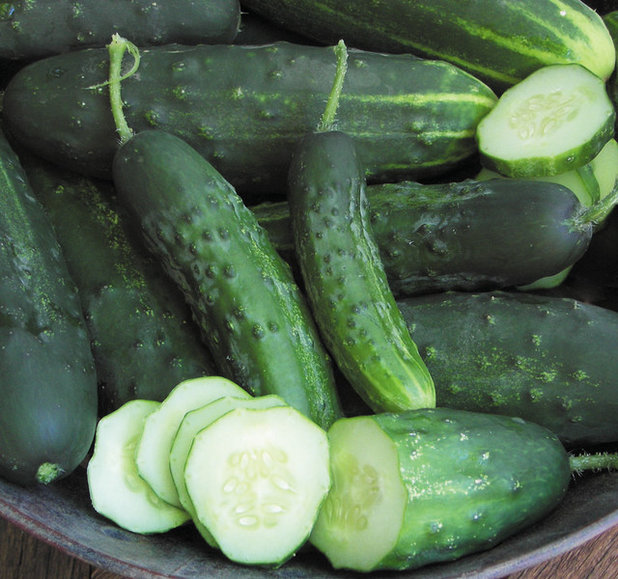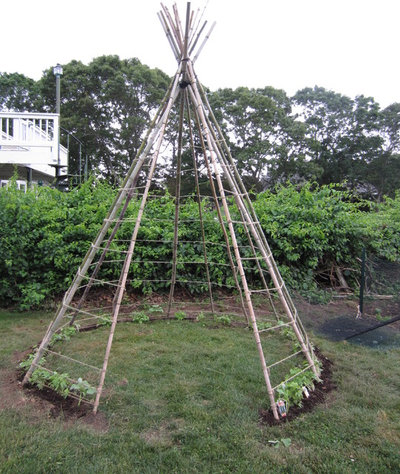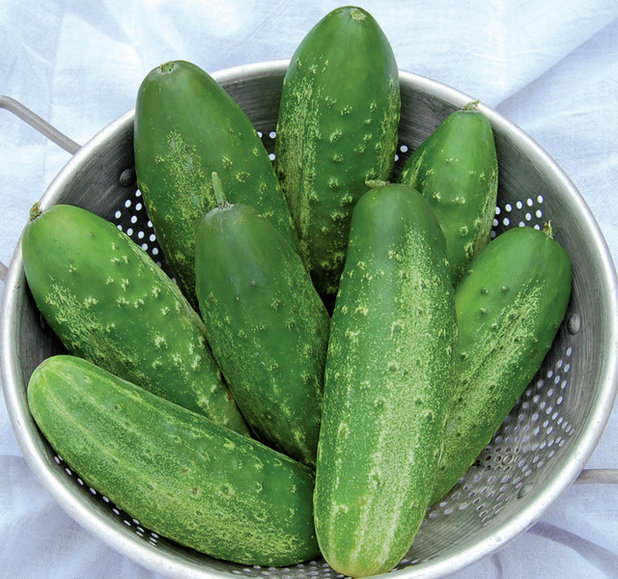Cucumbers are versatile vegetables that are easy to grow in summer. They can be eaten raw; added to lemonade or a mojito; sautéed; pureed into a dressing, yogurt dip or soup; or pickled. And they’re prolific producers. While they tend to sprawl, their vining habit lets you grow them as a vertical accent in your vegetable garden, training them up a trellis, over an old ladder or along a fence. The compact bush varieties are also a good choice for small gardens or containers.
The two main categories of cucumbers are
slicers, used when freshly picked, and
picklers, which are pickled or preserved, but there’s overlap between the two, as some slicers can be pickled and some picklers can be used fresh. Slicers are generally darker green, long, smooth and thicker skinned, while picklers are shorter and bumpier. Specialty cucumbers include white, yellow and brown cucumbers and the long Asian and Armenian varieties. You’ll also find cucumbers bred to reduce bitterness or to eliminate burping.
Note: Most cucumbers bear both male and female flowers, necessary for pollination. Some bear only female flowers, producing more fruit but necessitating a variety with male flowers planted nearby. Some seedless varieties don’t require any pollination.
More guides to summer crops

seedsavers.org
When to plant: Once all danger of frost has passed and soil temperatures reach 60 degrees Fahrenheit (16 degrees Celsius)
Days to maturity: Generally 48 to 70; some as long as 80
Light requirement: Full sun
Water requirement: Constant moisture
Favorites:- Slicers: Ashley Slicing, Bush Champion, Diva (seedless), Early Fortune, Fanfare, General Lee, Gold Standard, Marketmore 76, Orient Express, Salad Bush, Slicemaster, Spacemaster, Straight Eight, Sweet Success
- Picklers: Alibi, Bush Pickler, Country Fair, Diamont, Endeavor, Northern Pickling, Parisian Pickling, Pickalot, Pioneer, Russian Pickling, Snow’s Fancy, Supremo Hybrid
- Specialty: Amira (Armenian type), Armenian, Edmonson, Green Fingers, India Poona Kheera (brown), Japanese Climbing, Lemon, Miniature White, Striped Armenian, Suyo Long (Asian), Tasty Jade (Asian), White Wonder
The Seed Savers Exchange has a good selection of heirloom varieties.

Maria Hickey & Associates Landscapes
Cucumbers, green beans and morning glories were planted at the base of this garden tepee. As it grew, kids enjoyed playing inside the leafy structure, then harvesting the crop.
Planting and care: Choose a site with fertile, well-drained soil. Sow seeds once the soil is warm and frost danger has passed. If you started plants indoors or are buying nursery starts, set them out at this time as well. If you’re using a support system, set this up when you sow seeds or plant seedlings. Place bush varieties a little closer together than what is recommended below for standard vining varieties. You can also sow successively to ensure a long harvest.
To grow in hills, make soil mounds 6 to 8 inches high and 4 to 6 feet apart. Form a watering basin around each mound or set up drip irrigation. Plant four to six seeds in a circle about 1/2 to 1 inch deep. Thin to two or three seedlings per hill.
If you’re growing them in rows, space the rows 3 to 6 feet apart and dig watering furrows along each row or install drip irrigation. Sow two to three seeds together, 1/2 to 1 inch deep and 8 to 12 inches apart. Thin to one seedling per grouping.
For containers, plant bush varieties in a pot that is at least a foot deep.
Cucumbers need consistently moist soil to prevent bitterness, so water them well when you plant them and continue to water vigilantly and regularly. Sprinklers can encourage mildew, so choose watering methods that won’t dampen the leaves.
Keep the soil around the plants weeded and mulched. Mulching under the fruits will help keep them clean, as will raising them off the ground. Fertilize the soil once the plants start to grow well, then again about four weeks later. You may need to protect very young seedlings from birds, but remove any netting or covers once flowers form to allow pollination.
Cucumbers are bothered by a litany of pests, including aphids, cucumber beetles, flea beetles, mites, squash bugs and squash vine borers. They also can succumb to anthracnose, bacterial wilt, mosaic virus and downy and powdery mildew.

seedsavers.org
Harvest: Harvest time depends on the type of cucumbers. Once the plants start producing usable fruit, cut them off the stems while the fruits are still young, as older ones can become seedy. Plan to pick several times a week; cucumbers grow quickly.
Slicers are generally good to use once they reach about 6 inches, picklers may be ready to go at 2 inches for sweet pickles and 5 inches for dill pickles; you may need to wait until long varieties reach 20 inches.
More guides to summer crops





